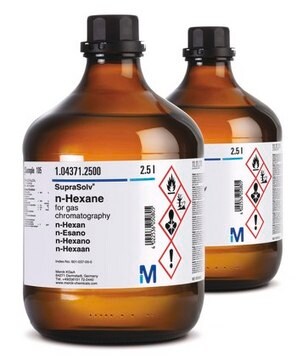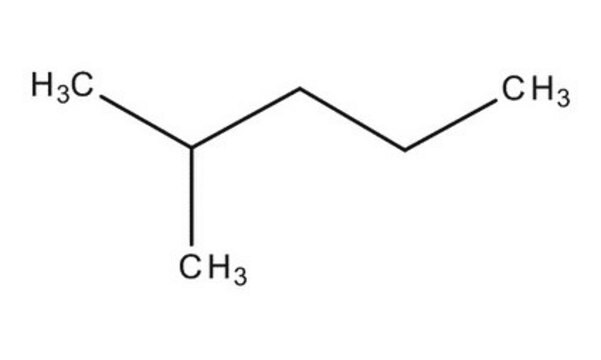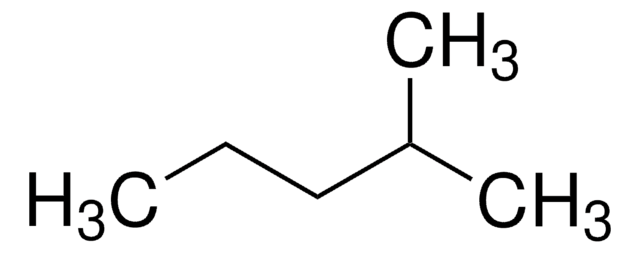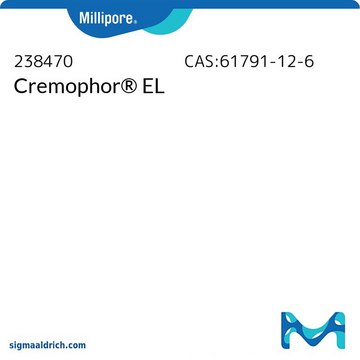1.04335
Isohexan
≥99.0% (GC), suitable for HPLC
Synonym(e):
Isohexan, 2-Methylpentan, iso-Hexan
About This Item
Empfohlene Produkte
product name
Isohexan, for liquid chromatography LiChrosolv®
Dampfdruck
160-190 hPa ( 20 °C)
Qualitätsniveau
Produktlinie
LiChrosolv®
Qualität
isocratic
Assay
≥99.0% (GC)
Form
liquid
Selbstzündungstemp.
260 °C
Wirksamkeit
>2000 mg/kg LD50, oral (Rat)
>2000 mg/kg LD50, skin (Rabbit)
Expl.-Gr.
1.0-7.4 % (v/v)
Methode(n)
HPLC: suitable
Verunreinigungen
≤0.0002 meq/g Acidity
≤0.0002 meq/g Alkalinity
≤0.005% Water
≤0.5% n-Hexane (GC)
≥60% Isohexane (GC)
Abdampfrückstand
≤2.0 mg/L
Farbe
APHA: ≤10
Durchlässigkeit
210 nm, ≥60%
220 nm, ≥80%
245 nm, ≥98%
kinematic viscosity
0.5 cSt(20 °C)
bp
53-63 °C/1013 hPa
mp (Schmelzpunkt)
<-50 °C
Übergangstemp.
flash point -21 °C
Dichte
0.66 g/cm3 at 20 °C
Lagertemp.
2-30°C
InChI
1S/C6H14/c1-3-5-6-4-2/h3-6H2,1-2H3
InChIKey
VLKZOEOYAKHREP-UHFFFAOYSA-N
Allgemeine Beschreibung
Anwendung
- In-house validation of accelerated solvent extraction-gas chromatography-mass spectrometry for the determination of bound 3- and 2-monochloropropanediols (MCPD) and glycidol in food products.: Diese Studie zeigt die Validierung einer robusten Analysemethode, die für die Gewährleistung der Lebensmittelsicherheit und die Einhaltung von Vorschriften von entscheidender Bedeutung ist. Die Verwendung von Isohexan in diesem Verfahren unterstreicht dessen Nutzen bei der Verbesserung der Extraktionseffizienz und der Analysepräzision (Shaari et al., 2021).
- Optimized determination of polybrominated diphenyl ethers and polychlorinated biphenyls in sheep serum by solid-phase extraction-gas chromatography-mass spectrometry.: Demonstriert die Optimierung von Extraktions- und Nachweistechniken unter Verwendung von Isohexan für Umweltschadstoffe in biologischen Proben, wodurch die Empfindlichkeit und Genauigkeit dieser Messungen verbessert werden (Zhang & Rhind, 2011).
- Simultaneous extraction and clean-up of polybrominated diphenyl ethers and polychlorinated biphenyls from sheep liver tissue by selective pressurized liquid extraction and analysis by gas chromatography-mass spectrometry.: In diesem Artikel wird eine optimierte Methode zur gleichzeitigen Extraktion und Reinigung spezifischer Verunreinigungen aus Lebergewebe beschrieben, wobei Isohexan eine entscheidende Rolle für die Effizienz des Extraktionsprozesses spielt (Zhang et al., 2011).
- Selective pressurized liquid extraction of estrogenic compounds in soil and analysis by gas chromatography-mass spectrometry.: Der Schwerpunkt liegt auf der gezielten Extraktion von Substanzen mit endokriner Wirkung aus Umweltproben, wobei die selektiven Solvatationseigenschaften von Isohexanen genutzt werden, um die Selektivität und Analytausbeute zu verbessern (Zhang et al., 2011).
- Fast sample preparation involving MASE and coupled column normal phase liquid chromatography for the rapid trace analysis of dioxins in air-dust samples from fire catastrophe emissions.: Es wird eine schnelle Vorbereitungs- und Analysemethode für Spurenverunreinigungen in komplexen Matrizen mit Betonung der Rolle von Isohexanen bei der Erzielung schneller und zuverlässiger Ergebnisse erläutert (van Beuzekom et al., 2004).
Angaben zur Herstellung
Hinweis zur Analyse
Isohexan (GC): ≥ 60,0 %
n-Hexan (GC): ≤ 0,5 %
Abdampfrückstand: ≤ 2,0 mg/L
Wasser: ≤ 0,005 %
Farbe: ≤ 10 Hazen
Acidität: ≤ 0,0002 meq/g
Alkalinität: ≤ 0,0002 meq/g
Durchlässigkeit (bei 210 nm): ≥ 60 %
Durchlässigkeit (bei 220 nm): ≥ 80 %
Durchlässigkeit (ab 245 nm): ≥ 98 %
Filtriert durch 0,2-µm-Filter
Sonstige Hinweise
Rechtliche Hinweise
Signalwort
Danger
Gefahreneinstufungen
Aquatic Chronic 2 - Asp. Tox. 1 - Flam. Liq. 2 - Skin Irrit. 2 - STOT SE 3
Zielorgane
Respiratory system
Lagerklassenschlüssel
3 - Flammable liquids
WGK
WGK 2
Flammpunkt (°F)
-5.8 °F
Flammpunkt (°C)
-21 °C
Zulassungslistungen
Zulassungslistungen werden hauptsächlich für chemische Produkte erstellt. Für nicht-chemische Produkte können hier nur begrenzte Angaben gemacht werden. Kein Eintrag bedeutet, dass keine der Komponenten gelistet ist. Es liegt in der Verantwortung des Benutzers, die sichere und legale Verwendung des Produkts zu gewährleisten.
EU REACH Annex XVII (Restriction List)
Analysenzertifikate (COA)
Suchen Sie nach Analysenzertifikate (COA), indem Sie die Lot-/Chargennummer des Produkts eingeben. Lot- und Chargennummern sind auf dem Produktetikett hinter den Wörtern ‘Lot’ oder ‘Batch’ (Lot oder Charge) zu finden.
Besitzen Sie dieses Produkt bereits?
In der Dokumentenbibliothek finden Sie die Dokumentation zu den Produkten, die Sie kürzlich erworben haben.
Kunden haben sich ebenfalls angesehen
Unser Team von Wissenschaftlern verfügt über Erfahrung in allen Forschungsbereichen einschließlich Life Science, Materialwissenschaften, chemischer Synthese, Chromatographie, Analytik und vielen mehr..
Setzen Sie sich mit dem technischen Dienst in Verbindung.













